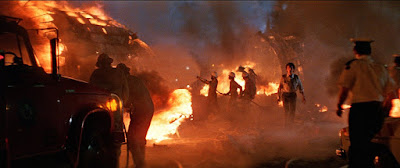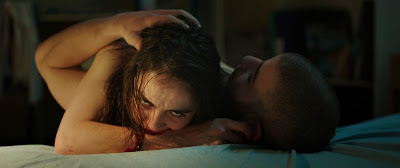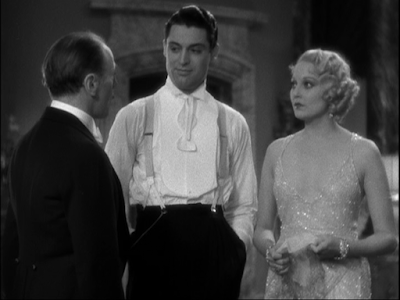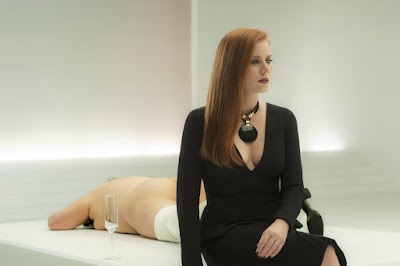Dennis Cozzalio has another of his movie quizzes up over at Sergio Leone and the Infield Fly Rule. Here are my answers. What you can deduce about me from the answers, I know not.
Saturday, November 25, 2017
Monday, October 16, 2017
Dr. Frankenstein, I Presume
It seems inconceivable to me that I'd never seen The Revenge of Frankenstein (1958, directed by Terence Fisher) before this week. I spent a lot of my youth watching Hammer films, particularly the Dracula series, yet this one somehow escaped me and I'm poorer for it. I know why I missed it. It's because a short passage in Carlos Clarens's An Illustrated History of the Horror Movie dismissed the film out of hand. Clarens noted that it was released on a double bill with Curse of the Demon, suggesting that Curse towers over The Revenge of Frankenstein, "which, in a wink, it eclipsed." It's hard to recover from that kind of dismissal. I think it's been in the back of my mind whenever The Revenge of Frankenstein has been presented to me. So I ignored the film for years. This is totally unfair to the film. I mean, Curse of the Demon is a masterpiece and you can't really compare any less than masterpiece to it and hope to have a fair comparison, but there's nothing inherently bad about The Revenge of Frankenstein. It's a handsome film. In its way, it might be the best of the Hammer Frankensteins, which is admittedly faint praise.
Posted by
Vulnavia Morbius
at
12:55 PM
0
comments
![]()
Labels: Hammer Studios, horror, horror movies, October Challenge, October Challenge 2017, The Revenge of Frankenstein
Friday, October 06, 2017
A Kaiju Haunting
Godzilla, Mothra, and King Ghidorah: Giant Monsters All-Out Attack (2001, directed by Shûsuke Kaneko) has a novel big idea. It postulates that the reason Godzilla favors attacking Japan over all other nations is because he is animated not just by the atom bomb, but also by the souls of all the pan-Asian dead of World War II. Japan, the movie further postulates, needs a reminder of its responsibility for that catastrophe. This is the kaiju equivalent of the J-horror films that are this movie's contemporaries, in which the giant monsters act as conduits for ghosts. Godzilla plays the role that the video tape played in The Ring, and that the internet played in Pulse. This is one of the rare late Godzilla films that casts Godzilla as a villain, rather than as a defender of Japan, a fact reflected in the design of its star: he has milky white eyes without pupil or iris, like he's possessed. This is one of the most lethal Godzillas, one possessed of an implacable malice rather than the indifference of a force of nature.
Posted by
Vulnavia Morbius
at
7:08 PM
0
comments
![]()
Labels: Godzilla, Godzilla Mothra and King Ghidora: Giant Monsters All-Out Attack, Japanese Cinema, kaiju
Sunday, October 01, 2017
Any Landing You Can Walk Away From
It's October again. That means it's time for the October Horror Movie Challenge, in which I try to watch 31 horror movies during the month, including at least 16 that are new to me. Given that I've been away from blogging for a while, this also means I'm going to try to write about all of them. Wish me luck.
The Survivor (1981, directed by David Hemmings) is a film I remember seeing on HBO way back in the early 1980s. While I say that I remember seeing it, I only remember seeing it because the plane crash that opens the film is spectacular and legitimately terrifying. It sticks in the memory. The rest? I vaguely remembered some of the film's ghostly shenanigans (the dude lured onto the train tracks for instance), and I remembered Jenny Agutter, but only in fragments. It turns out that there's a reason for that. It's a slow, meandering film that has none of the pulp vitality you would expect from a film based on a James Herbert novel. And yet, here it is.
Posted by
Vulnavia Morbius
at
10:33 AM
0
comments
![]()
Labels: Australian cinema, horror movies, October Challenge, October Challenge 2017, The Survivor
Tuesday, July 11, 2017
Hey kids! Comics! A Teachable Moment
The editors of We're Still Here have linked to my movie blog instead of my comics and art blog, so I thought I'd provide a landing sport that shows some of my comics. This is a piece I did for an anthology that seems to have fallen through, so I thought I'd publish this here instead as a kind of teaser for the comics I draw. Enjoy.
Posted by
Vulnavia Morbius
at
10:22 AM
1 comments
![]()
Labels: comics, Shameless Self-Promotion
Thursday, July 06, 2017
Shameless Self-Promotion: We're Still Here
The Kickstarter for We're Still Here, a comics anthology by trans creators, is live. There's a long story by yours truly in this book and I want to see it in print (and get paid for my work). So if you're interested, there are fifty trans cartoonists involved and the book will be fabulous.
Posted by
Vulnavia Morbius
at
7:29 AM
0
comments
![]()
Labels: Kickstarter, Shameless Self-Promotion, We're Still Here Anthology
Monday, June 26, 2017
Bullets and Bracelets
Sing, O goddess, the wrath of Diana of Themyscira, daughter of Queen Hippolyta, that brought countless ills upon the scions of Germany. Many a brave soul did her ruinous wrath send down to Hades, many a hero did it yield to dogs and vultures. For so were the counsels of Zeus fulfilled from the day on which Hippolyta, queen of Amazons, and her thoughtless daughter first fell out with one another.
When I was a kid in the 1970s, I watched the Lynda Carter version of Wonder Woman religiously. I was 8 when the show premiered. It was one of the only times popular culture let me exercise my inner aspirations for my gender identity without betraying them to the world at large. I've heard a lot of women my age talk about how they played at being Wonder Woman in the 1970s using Underroos as costumes and jump ropes as Lassos of Truth. I didn't get to do any of that, though I might have wanted to. My neighbor across the street was such a girl and I was insanely jealous of the fact that she had a Wonder Woman tiara and bracelets. I had to settle for pretending to be Batman, which was acceptable to a point. I couldn't do the things I wanted as play activity, but I could watch the show, and watch it I did. Because it was superheroes and nominally an action show, it was permitted for someone who was perceived to be a boy. But it spoke to me as a girl. Wonder Woman was an aspirational figure: gorgeous, badass, invincible. Hell, even her secret identity, Diana Prince, worked for a spy organization. No life of motherhood and housewifery for her. Moreover, there was a transformational element to Wonder Woman that was absent in her near contemporary rival for girl power superheroics, The Bionic Woman. Jamie Sommers required six million dollars worth of bionic upgrades to become a hero, which was way out of reach to a lower middle-class kid like me. Diana Prince spun around and magically transformed into Diana of Paradise Island. There's a hardcore wish fantasy involved with Wonder Woman's spinning transformation, which maybe explains how Wonder Woman's fantasy gifts seemed more attainable than Jamie Sommers's technological ones. Magic doesn't have a price tag, after all. A lot of girls my age spent time spinning in hopes of becoming Wonder Woman. I did it myself in private moments every once in a while.
Wonder Woman comics in the 1970s were lousy, though. Her best stories generally appeared in team books like Justice League of America, where she was often sidelined in favor of male characters, or damselled. In her own book, the stories were often silly and usually pretty patronizing, even when the creators were aware of her status as a feminist icon. The first Wonder Woman series I ever bought was Kurt Busiek and Trina Robbins The Legend of Wonder Woman mini-series, followed closely by George Perez's revamp in 1987. The Legend of Wonder Woman was a loving pastiche of the original Golden Age version of the character, while Perez's book re-imagined her along more mythological lines. Perez's version is the canon from which the current character is drawn and it populates Wonder Woman's rogues gallery with mythological figures in preference to costumed enemies (though some of those show up too). It also changes Wonder Woman's mission in the world. She is an ambassador for both Themyscira and Amazonian ideals of peace and kindness. Moreover, the Perez comics largely avoid a male gaze when drawing both Diana and the other women who populate the story. The Amazons themselves and their island and Mount Olympus itself are rendered in loving pastiche of Hellenic art and architecture, often crossed with the gonzo spacial experiments of M. C. Escher. Perez provides Wonder Woman with an arch-enemy in Ares, the God of War. These comics are mostly pretty good. They are state of the art (in 1987) traditional comics. They stand out in stark contrast to the deconstructive versions of Batman and Superman and superheroes in general that are their contemporaries.
But they have their issues.
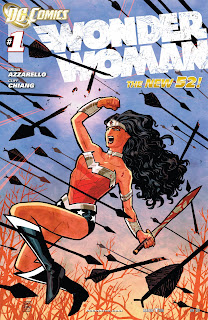 Most comics created almost exclusively by men are going to step on their own dicks when writing about women eventually, and the Perez version of Wonder Woman is no different. In one issue, Diana's friend, Julia, goes off on the god, Hermes, with a righteous anger that's fully justified. At the end of the book, her outburst is written off by the character herself as menopausal, as if women's anger isn't justifiable if there's not an underlying feminine reason. Menopause, PMS, whatever. That's not to say that men can't write about women or Wonder Women specifically--Greg Rucka's superior version of Wonder Woman is largely free of this kind of shit--only that these things often happen when they do. The New 52 version of Wonder Woman, which debuted in 2011, is almost laughable in its anti-feminism. It's as if writer Brian Azarello went through the Perez origin story with the intention of demolishing its finer points, as if he wants to say, "Look! The Amazons are just as bad as Patriarchy." As if to establish a false equivalence between feminism and patriarchy. When Azarello revealed that the Amazons repopulated Themyscira by raping men and selling resulting male children into slavery, I should have checked out (the lovely Cliff Chiang art kept me reading for a while afterward, much to my chagrin). When the New God, Orion, slapped Diana on the ass and she failed to even attempt to rip his arm out of its socket, I did check out. (1) The New 52 more generally pursued a misguided romance between Diana and Superman that was just too much to bear. DC comics of the current decade really doesn't understand the appeal of most of their characters when they aren't brooding dark-night vigilantes.
Most comics created almost exclusively by men are going to step on their own dicks when writing about women eventually, and the Perez version of Wonder Woman is no different. In one issue, Diana's friend, Julia, goes off on the god, Hermes, with a righteous anger that's fully justified. At the end of the book, her outburst is written off by the character herself as menopausal, as if women's anger isn't justifiable if there's not an underlying feminine reason. Menopause, PMS, whatever. That's not to say that men can't write about women or Wonder Women specifically--Greg Rucka's superior version of Wonder Woman is largely free of this kind of shit--only that these things often happen when they do. The New 52 version of Wonder Woman, which debuted in 2011, is almost laughable in its anti-feminism. It's as if writer Brian Azarello went through the Perez origin story with the intention of demolishing its finer points, as if he wants to say, "Look! The Amazons are just as bad as Patriarchy." As if to establish a false equivalence between feminism and patriarchy. When Azarello revealed that the Amazons repopulated Themyscira by raping men and selling resulting male children into slavery, I should have checked out (the lovely Cliff Chiang art kept me reading for a while afterward, much to my chagrin). When the New God, Orion, slapped Diana on the ass and she failed to even attempt to rip his arm out of its socket, I did check out. (1) The New 52 more generally pursued a misguided romance between Diana and Superman that was just too much to bear. DC comics of the current decade really doesn't understand the appeal of most of their characters when they aren't brooding dark-night vigilantes.
In any event, these are the poles of depiction that the new film version navigates.
Posted by
Vulnavia Morbius
at
5:30 AM
1 comments
![]()
Labels: 2017, annoying personal anecdotes, comics, feminism, films by women, Superheroes, Wonder Woman (2017)
Tuesday, May 16, 2017
Maneater
I wasn't expecting Raw (2016, directed by Julie Ducournau) to be funny. I mean, French extreme horror movies like Inside or Martyrs are often grim to a point where they cease being entertainments and become endurance tests. Raw is definitely in the tradition of those films, but Raw isn't like that. Don't get me wrong: Raw is a profoundly disturbing and visceral movie, one that isn't shy about employing a gross-out scene here and there. Nor is its splatter of a slapstick variety, a la The Evil Dead. It's a deadly serious movie. And yet there are laughs to be had; some laughs come from actual jokes, some come from the cinematic audacity of the filmmakers. And some of them come from the way the filmmakers take the horror genre's structure and combine it with a contemporary naturalism. The way this is filmed doesn't feel like it's necessarily a horror movie, but the structure of the film, from its alarming first scene to its final whip of the tale, is derived almost entirely from the genre. I suggested to friends that after the final scene unfolds, I wouldn't have been surprised to find the Crypt Keeper sending the audience to the exit with some ghastly bon mot. Writer/director Julie Ducournau, making her first feature, is keenly aware of her traditions. The resulting film is self-aware and funny without being a parody.
Posted by
Vulnavia Morbius
at
1:59 PM
0
comments
![]()
Labels: 2016, 2017, feminism, films by women, French Film, French Horror, horror movies, Raw (2016)
Saturday, April 08, 2017
The Grant Mystique: Wings in the Dark
By 1935, Cary Grant was becoming a headline attraction. His signature roles were still ahead of him, but he had enough box-office appeal that he was rarely very far down the cast list when he wasn't actually top-billed. He's second-billed in Wings in the Dark (1935, directed by James Flood) behind Myrna Loy, who was coming off the success of The Thin Man. This was the first of three films Grant made with Loy, the other two being the post-war sitcoms, The Bachelor and the Bobby-Soxer and Mr. Blandings Builds His Dream House. Both of those films were made at the height of Grant's stardom, when he had become the archetype of the movie star. He was top-billed in both and they're both fondly remembered, but in truth, I like Wings in the Dark more than either of them. Bachelor and Mr. Blandings are both more tightly scripted, more lavishly budgeted, more concerned with realism, more conceived of as product. Don't get me wrong! I like them both. But they tend to make of Grant, the movie star, into a middle-class mediocrity. They attempt, at their peril, to make Grant relatable to the new, post-war middle class, to the average Joe who was moving to the suburbs on the GI Bill. In short, they tried to rob Grant of his movie-star mystique (and nevermind that knight in shining armor gag in Bachelor). Wings in the Dark is a much rougher film, not really more than a b-picture that would be forgotten if not for its stars. I'll agree that as a formal object, it's probably not as good as Bachelor or Mr. Blandings. In fact, it's utterly ridiculous. But unlike those films, it doesn't squander Grant's persona. Wings in the Dark lets Grant explore his role in a way that would be unthinkable once he became the archetype of the movie star. It's a film that lets Grant be an actor first.
Posted by
Vulnavia Morbius
at
6:09 PM
1 comments
![]()
Labels: Cary Grant, classic film, Wings in the Dark
Saturday, March 11, 2017
A Short Update
Oh, hai. According to my analytics, there are still people coming to my blog every day, so I thought I'd stop in and let you all know what's going on with me and what's going on with Krell Laboratories. I mean, I haven't posted anything since January. February was the first month in over a decade with no postings at all. Given that I get paid when I post, this is a bad situation for me, but there are extenuating circumstances. One: I've been sick. I've had a nasty respiratory infection since the beginning of February and it's hard to work up the gumption to write anything when you're in the process of coughing up a lung. I joked on Facebook that I have consumption and that I should move to Tombstone, Arizona for the weather and take up card-playing, loose women, and absinthe. I frame everything in my life through cultural references, sometimes.
Moreover, I've been poor. This is related to being sick. I have only been able to work intermittently over the last month and a half and since I'm not working a full-time day job, it means I have no paid sick leave. I'm not in danger of losing my job, but every day I miss because I'm sick is a day I'm not making any money. I am being sensible and not spending my money on movies right now, preferring to spend it instead on my mortgage and food. And on days I am working, I am otherwise occupied. I have not seen Get Out or Logan or Kong of Skull Island or Hidden Figures or Arrival or Lion or a bunch of other films recently in theaters. I want to, but I'm probably waiting for video or streaming on most of it.
On a more personal note, I've been spending a lot of my available time on defending myself from the Trump government. I've been playing an intense version of the identity document whack-a-mole that all transgender people play if they transition as fully as I have. I've been engaging in a bunch of activism, too, which isn't exactly a new thing for me, only newly urgent. I've been trying very hard not to freak out and do something completely stupid like move to Argentina with no job or friends waiting for me. It's been stressful.
Finally, I've been...well, blocked I guess. I've started, literally, dozens of posts over the last year and a half that have died a quick death as I've run out of things to say or run out of words to say them. I wrote about my favorite film of last year--The Witch--when it was in theaters and that post was easy. Sometimes it just flows like I'm a conduit for words; its a form of automatic writing. I didn't write about my second favorite film of last year--Sing Street--because I couldn't find a way into it (you should see it, by the way; it's on Netflix). Ditto some of my other favorites from last year, whether Scorsese's Silence or Park's The Handmaiden or Moonlight or 20th Century Women or OJ: Made in America or Manchester by the Sea or most of the other films I submitted on my ballot for the Muriel awards. Do I want to engage with these films? Mostly yes. The words just haven't come. It's frustrating.
So I'm going to try something a little different now.
I was sitting on the couch watching Joe Dante's Explorers, a film I liked when I saw it in theaters all those years ago, when it struck me that Ethan Hawke is the perfect actor for Richard Linklater's Boyhood, because Hawke is one of those child actors you can watch grow up on camera. He was 13 when he filmed Explorers. Every subsequent film is like revisiting him to see how he's coming along, like he's participating in a strange version of the "Up" documentaries. And it's this way for all child actors who act into adulthood. When I started to think about this, I realized that Christina Ricci is likely fixed in the popular imagination forever and ever as Wednesday Addams, a part she first played when she was ten, and that no matter what she has done as an adult, that image will always follow her. There's a little bit of Wednesday in her version of Lizzie Borden, I think. She's 37 now, which makes me feel old. I remember seeing a rerun of one of Kurt Russell's first films, Follow Me Boys, at a drive-in double with Pollyanna sometime in the early seventies, a film made when Russell was a wee boy. He's an old man now. You can watch him age film by film. All of which is a reminder that even fictional films are documentaries of a sort. They capture a shadow out of time. They're a medium for making ghosts.
These are the kinds of things I think about when I'm alone in the house and stuck inside my own head for long periods.
Ordinarily, I'd be writing about The True/False film festival around now. The festival played this past weekend. I didn't get to go, even though I selected ten films to go with my pass. I gave my pass and my tickets to my partner so she could go see something. I stayed home and coughed all weekend. Woe is me. That said. I've seen a bunch of the films that played there. Of the films I saw before the festival, the ones I liked best were I Am Not Your Negro and Rat Movie. I Am Not Your Negro is a hit beyond the festival circuit and an Oscar nominee this year. It would have been my choice of the nominees, though any of them would have been an honorable choice for a change. I don't begrudge OJ: Made in America its win even though I think it's television and not cinema, but a masterpiece none the less. That boundary blurs more and more day by day anyway. Besides, taken as a triptych, I Am Not Your Negro, 13th, and OJ are a powerful expression of why we are in the mess we're in in the United States, as if they were three parts of the same film. I Am Not Your Negro filters its view of race and America through the eyes of James Baldwin, who was clear eyed about his country, even as it murdered his friends. Rat Movie, a film about the history of rats and rat extermination throughout the history of Baltimore, is almost as racially charged. It's a mosaic film in which public health, neighborhood redlining, involuntary experimentation on minority populations, and rats themselves entwine into a damning critique of American racism. It's a bracing film.
Of this year's films, the one that's most typical of True/False's mission of examining the liminal space between truth and fiction is Kitty Green's Casting JonBenet, which examines the case through the eyes of actors auditioning for parts in a hypothetical film version. Each actor has a different take on the character for which they're auditioning, and each actor brings their own personality to the audition process, creating a weird metacinematic doorway between past and present. The end of the film, in which all of the actors appear during the filming of the fake film is a bravura piece of stagecraft. I don't think it sheds any light on the actual case, but that may be the point.
Anyway, I'll try not to stay away so long.

This blog is supported on Patreon by wonderful subscribers. If you like what I do, please consider pledging your own support. It means the world to me.
Posted by
Vulnavia Morbius
at
6:14 PM
1 comments
![]()
Labels: annoying personal anecdotes, True/False 2017, True/False Film Festival
Monday, January 16, 2017
The Grant Mystique: This is the Night
There are more films starring Cary Grant in my movie collection than films starring any other actor. No small feat given how many films I have with John Wayne, Humphrey Bogart, and Christopher Lee, respectively. I think John Wayne may have been in the lead until this Christmas, when my main Christmas gift was the Universal Vault Collection of Grant's early films, most of them from the pre-1950 Paramount library that Universal owns. They've been stingy with that library over the years. Many of the films in this set have never seen a commercial release for home video. In any event, this set has eighteen films, all made before 1937, before Grant was "Cary Grant," before he had fully developed the Grant persona (stolen from Leo McCarey on the set of The Awful Truth, if you believe McCarey on the matter). Grant's star became a supernova after 1937, when he began appearing in some of his best-loved films, including Topper and the aforementioned The Awful Truth. The films in The Vault Collection are not so well-known as a rule. Oh, it has the two films Grant made for Mae West, sure, and Blonde Venus with Marlene Dietrich and Joseph Von Sternberg, but those aren't really "Cary Grant" films, even if Mae West recognized a diamond in the rough when she saw one. West had an eye for diamonds.
Posted by
Vulnavia Morbius
at
7:22 AM
0
comments
![]()
Labels: Cary Grant, classic film, comedy, Pre-Code, This is the Night
Saturday, January 14, 2017
Winter 2016: Jazz
On the evidence of Whiplash and La La Land (2016), director Damien Chazelle sure likes jazz. He likes it so much that he wants to save it from its death spiral, single-handedly if necessary. Maybe he'll succeed. I don't know. I wish he'd try harder to save it with actual black people, you know? The people who actually invented jazz? But, like it or not--and this film doesn't--black people have moved on to other forms of expression, leaving jazz to (mostly white) academics and nostalgics. I think Chazelle is an academic, however much he wants to express a visceral passion for jazz in his films. There's a scene in La La Land where he tries to convey what jazz has become versus what he thinks jazz ought to be when he has his hero, Sebastian, a jazz pianist, trying to mansplain why his heroine, Mia, an aspiring actress, should like jazz even after she's said she doesn't like it. This resonated in my head with some recent articles in Seattle's The Stranger about bands one woman pretended to like to impress boys and it dropped me out of the movie for few minutes, a discordance that echoed back later in the film where the filmmakers tip their hats to Vertigo, which similarly follows a man who wants to remake a woman. So, basically, the politics of images in La La Land are somewhat problematic.
Posted by
Vulnavia Morbius
at
4:58 PM
0
comments
![]()
Labels: 2016, La La Land, music
Monday, January 02, 2017
Winter 2016: Nocturnal Ocean Beasts
Here are some comments on some of the films I've been seeing this month. I don't have the heart or fortitude for my usual jeremiads right now, so these are brief.
Posted by
Vulnavia Morbius
at
10:18 AM
3
comments
![]()
Labels: Allied, animation, Fantastic Beasts and Where to Find Them, Fantasy, Moana, Nocturnal Animals



